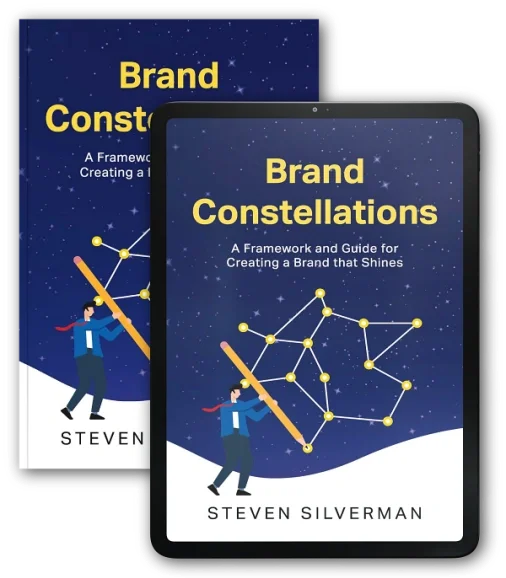
Standing Out in a Crowded Market: How to Position Your Brand with the Brand Constellations Framework
Standing out in a crowded market is a challenge. What makes your brand unique and memorable? The Brand Constellations Framework provides a strategic approach to branding.
This framework breaks down branding into eight dimensions, or “stars”—Product, Placement, Price, Promotion, Category, Competitors, Company, and Customer—each providing a pathway to help you carve out a distinct position in the market. The Stars come together in people’s minds to form a holistic view of the brand called a Brand Constellation.
Whether you’re managing an established brand or creating a new one, let’s explore each Star and how it can help your brand shine brightly.
Product: Innovate and Build Quality into the Core
Differentiation often begins with the product itself. Highlight what sets your offering apart. Is it the design, the formula, or the experience?
Dyson is a prime example. Dyson's brand is built on innovative vacuum technology. It was a powerful, sleek, bagless design. Dyson built a successful brand by offering products with clear, distinct features.
Identify your product's unique selling points. What problem does your product solve? What can I do to ensure that my product consistently reflects the brand promise?
Placement: Be Accessible and Strategic
How and where customers find your product can make it stand out. Nike is a brand that understands the power of omnichannel placement. Nike's combination of stores, online shopping, and a mobile app provides customers with convenient access to their products.
Exclusive placements add prestige. Louis Vuitton maintains exclusivity by limiting distribution to select stores. Strategic placement means being where your customers are and making every interaction easy.
Price: Reflect Brand Value Through Pricing Strategy
Pricing communicates your brand's market positioning. Rolex's high price reflects more than just watch quality. Customers buying Rolex watches are paying for more than just the timekeeping function; they're buying prestige.
Walmart has positioned itself as the affordable choice, appealing to budget-minded consumers. Both strategies reflect brand value in pricing. Your pricing strategy should reflect your brand's image, regardless of whether you choose premium, value-based, or dynamic pricing.
Promotion: Engage and Connect Emotionally
Emotional connections can be fostered through promotion. Coca-Cola's "Share a Coke" campaign, featuring personalized bottles, is a great example of this. This promotion fostered personalization and encouraged customer sharing, boosting brand loyalty and engagement.
A unique brand position is built through storytelling. Patagonia's marketing reflects its dedication to environmental responsibility. Patagonia uses conservation stories to create a movement and connect with its values-driven customers.
What stories can your brand tell? How can promotions evoke emotional connections with your audience?
Category: Define or Redefine the Playing Field
Sometimes, the best way to stand out is to create or redefine a category altogether. Tesla did this with electric vehicles. Tesla established a unique position by pioneering luxury electric cars. It didn’t just join the car industry. It reshaped it.
Focusing on a niche can redefine a category. Red Bull targeted consumers seeking a boost, not just a sugary drink. This made Red Bull the leading brand in a new market.
Find your brand's unique position in the market. What unique audience or need can you address?
Competitors: Differentiate Through Values and Personality
Competition is fierce, but being better isn't the only way to stand out. Wendy's has become popular on social media due to its playful and sometimes cheeky personality. Wendy's differentiates itself through its unique brand voice.
Consider positioning your brand against a well-known competitor. Pepsi aims for a "bold" image, contrasting with Coca-Cola's "classic" identity. Pepsi's distinct brand appeals to customers seeking individuality.
Company: Build on Authenticity and Strong Values
Company culture shapes your brand. TOMS is built on social responsibility. The "Wear Good" model, giving 1/3 of profits to mental health organizations, highlights their commitment to social good. TOMS stands out in the footwear industry because of their commitment to giving back.
A strong, authentic culture helps your brand connect with like-minded customers. Consumers connect with authentic brands that have a purpose.
Customer: Foster Personal Connections and Engage Continuously
The customer star aims to make every customer feel valued. Netflix personalizes its recommendations based on your preferences. Personalized content drives user engagement on Netflix.
Engage customers in the brand journey. LEGO Ideas is an ongoing initiative where the company invites fans and customers to submit their own designs for new LEGO sets. The platform allows participants to share their creations, gather votes from the community, and potentially see their ideas turned into official LEGO products. Submissions that reach 10,000 votes are reviewed by LEGO's design and marketing teams for production consideration.
Engage customers beyond the purchase to stand out. A customer-centric approach, using personalization, exclusivity, and direct involvement, enhances brand memorability.
Positioning Your Brand for Success
Standing out in today’s market isn’t about being louder. It’s about being smarter. The Brand Constellations Framework uniquely positions your brand across all dimensions. Attention and loyalty are built by thinking holistically and strategically about product, culture, promotion, and pricing.
How can you make each star stand out in the market? What dimensions enhance your brand's distinctiveness? The Brand Constellations Framework highlights how aligning your brand's strengths can make it stand out and win in a competitive market.



